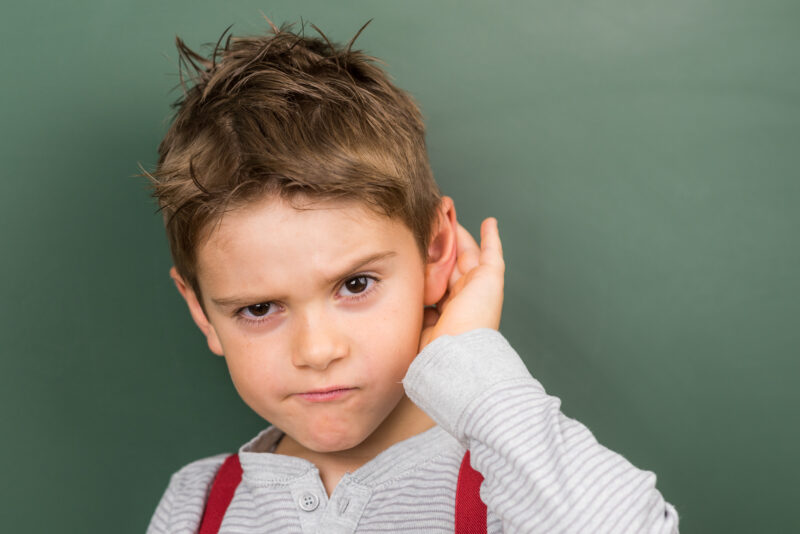Was bedeutet es für den Alltag, einseitig taub zu sein?
Unsere Ohren sind keine redundanten Systeme, das zweite Ohr ist keine Reserve: Nur wer beidseits gut hört, kann alle Hörfähigkeiten entwickeln, die wir im Alltag benötigen. Was kann man tun, wenn man einseitig taub ist?
 Wird ein Kind mit nur einseitigem Hörvermögen geboren, ist es nicht per se glücklicher oder unglücklicher als andere Kinder. Ohne Unterstützung könnte diese Einseitigkeit aber bald zu Herausforderungen und Problemen führen, die das Potential hätten, unglücklich zu machen.
Wird ein Kind mit nur einseitigem Hörvermögen geboren, ist es nicht per se glücklicher oder unglücklicher als andere Kinder. Ohne Unterstützung könnte diese Einseitigkeit aber bald zu Herausforderungen und Problemen führen, die das Potential hätten, unglücklich zu machen.
Hören auf beiden Seiten
Wir benötigen für die sozialen Hörfähigkeiten den auditiven Input von beiden Seiten:
- Sprachverstehen bei Umgebungsgeräuschen: Um die Stimme meines Gesprächspartners aus den Umgebungsgeräuschen herauszufiltern, benötige ich beide Ohren. Mit nur einem Ohr muss ich mich viel mehr auf meine GesprächspartnerInnen konzentrieren, ermüde schneller und habe weniger Konzentrationsfähigkeit für andere Dinge: zum Beispiel den sachlichen Inhalt des Gesprächs. Das macht sich spätestens in der Schule bemerkbar: ein schlechterer Notenschnitt bis hin zur Wiederholung einzelner Schulklassen, geringeres Selbstvertrauen und Selbstwertgefühl können folgen.
Auch für die Entwicklung von Sozialkompetenzen ist das genaue Hören und das „Mithören“ von Gesprächen in Alltagssituationen auch bei Hintergrundgeräuschen wichtig.
- Gespräche und Geräusche auf der tauben Seite: Betroffene überhören oft, wenn sie von der tauben Seite angesprochen werden, aber auch Warnsignale auf der tauben Seite werden nicht oder verspätet wahrnehmen: das Horn eines Rettungswagens, eine Autohupe oder das Motorengeräusch eines herannahenden Wagens oder auch ein warnender Zuruf.
- Richtungshören: Die Richtung einer Schallquelle zu bestimmen, fällt mit nur einer hörenden Seite schwer. Damit benötige ich bei Gruppengesprächen länger, um den Kopf in die Richtung des/der neuen SprecherIn zu drehen – und somit visuelle Hilfen beim Verstehen zu nutzen. Auch bei Gefahrensignalen kann ich die Richtung schwer bestimmen.
Einseitig taub – die Folgen
Wenn diese sogenannten binauralen Hörfähigkeiten fehlen, bzw. man einseitig taub ist, führt das auch dazu, dass Betroffene leicht zu AußenseiterInnen werden. Nachvollziehen können Sie das, wenn Sie die ersten drei Teile des interaktiven Spiels „Switch on Life“ ausprobieren.
Außerdem klagen einseitig taube Menschen oft schon in jungen Jahren über Probleme im Nacken: Immer die hörende Seite dem/der SprecherIn zuzuwenden, führt im Klassenzimmer, bei Vorträgen, im Theater und selbst beim Spaziergang mit FreundInnen zu unnatürlich einseitiger Haltung.
Was man beachten muss, um auf beiden Ohren zu hören
- Beim Hörtest immer beide Seiten getrennt testen!
- Immer jedes hörbeeinträchtigte Ohr adäquat unterstützen: Bei einseitig schwerhörigen oder tauben Kindern oder Erwachsenen ein Hörsystem für die betroffene Seite, bei beidseitig Betroffenen für beide Seiten!
Tipps und Übungen, wie Sie die Entwicklung binauraler Hörfähigkeiten bewusst unterstützen können, finden Sie auch in der Elternbroschüre für beidseits CI-versorgte Kinder.

Sie lesen gerade:












